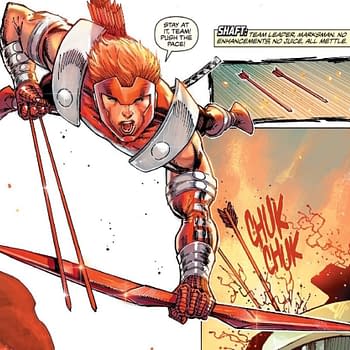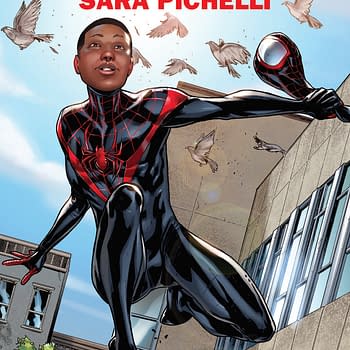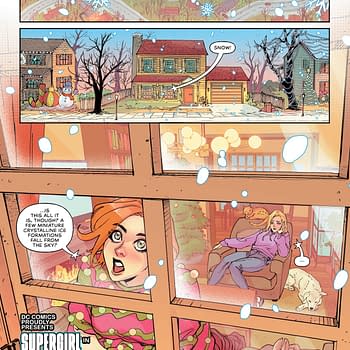Posted in: Comics | Tagged: Comics, phill hall
My Monthly Curse by Phill Hall #11 – Those Spider-Man Blues

Spider-Man #1 just wouldn't go away and as a measure of how desperate some people were to recoup their losses on X-Men #1 they kept putting the prices up despite demand having dropped off almost completely. No one was buying X-Force or X-Men now and while sales on the new comics were high and most retailers were now ordering conservatively again, the unsolds were a constant reminder of how their own foolishness and overzealous behaviour had almost put many out of business. People were desperately looking for something to recoup the losses and it came from one of the most unlikely of sources – my brother.
Ron Hall Jr was (and to some extent, still is) something of an employment nomad and I often got a laugh from friends by saying that he'd moved to Liverpool to join all the other unemployed people – but he was the one who originally said it. You couldn't wish to meet a more likeable person. Where I've had more than my fair share of enemies over the years, my brother seems incapable of falling out with anyone. He's also something of a chameleon. He takes on things he likes – styles, tastes … even occupations and does a really passable impersonation.
He had spent a lot of time helping me track down a lot of comics collections for my shop before it had opened and probably felt that by living in a huge city like Liverpool, he could possibly break into comics himself. So, by buying up whatever he could and working out of his lock-up garage, that's exactly what he did, much to my dismay. Also to my dismay was the fact that within two years he'd become a far more successful comic mart dealer than I could have wished for. He knew bugger all about comics and that lack of knowledge never changed, but he showed many how it should be done. Ironically, my brother struck up a friendship with an old friend, a guy called Colin Gould who I wrote a comics news column with back in the 1970s.
One quiet day, around the time the X-Men feeding frenzy would begin, he was looking through a stack of comics he'd just bought from a dealer who was packing up. Among the boxes were about 200 copies of the new Spider-Man #1 in an assortment of the previously mentioned variants. He had as much interest in reading comics then as he does now – zero, but he thought he'd look through an issue of Spider-Man to see what all the fuss was about. He opened the pages to see Spider-Man fighting The Lizard just as he was in the 3 million other copies – except there was something a bit wrong. For those of you who don't know the Lizard is a villain, of sorts, who was originally a biologist with an arm missing. In an attempt to try and synthesise in a human how some reptiles can grow missing tails back, the biologist turns himself into a 400lb scaly lizard man. He's been around for years and always wears his lovely white lab coat to nicely contrast with his bright GREEN skin. The copy in my brother's hands had Spider-Man fighting the Lizard except the Lizard was bright BLUE.
To the trained eye it was a simple mistake – sheets of print had been collated that had come off the presses at the end of a run and one of the ink levels – this time yellow – had run out. But to my speculator brother it was something else entirely. With the aid of his unwitting accomplice – me – he set about turning Spider-Man #1 into a really hot speculator comic.
The 'Blue Variant' is possibly the most ridiculous 'rip-off' ever to happen in comics. There were probably many thousands of misprinted comics in existence and none of them are ever worth anything. In fact, most comics fans want the perfect comic and will ignore the misprints – they are faulty goods and therefore have no value.
Wrong.
I was always on the look out for comics speculator news, it helped fill Movers and Shakers, but I couldn't always attend comic marts for my research, so I had a network of trustworthy people who reported on what was hot and what wasn't. One of them was my brother-in-law Neil, the one who had got me back into comics (and the one I'd taught how to lie). He came back from a mart in Leeds with the news that a new comic had taken the show by storm, except it wasn't a new comic at all, it was Spider-Man #1 and it was selling for £5. Impossible, I proclaimed, I was, after all, the oracle of all comics economics, I would have heard, surely?
He filled me in with all the details; the issues that sold had 8 misprinted pages, all of them devoid of yellow. I laughed and made a comment about how fools and their monies are soon parted. The following week, just prior to Movers deadline, I heard the 'Blue Variant' was now selling for between £8 and £10. It had, it seemed, become genuine news and it took the lead story. The next morning I went through all my unsold issues of Spider-Man #1 and found 7 of my own 'Blue Variants' – just how many of them were there?
Over the next three months the price went up as high as £50 and while it was never recognised as officially anything other than a misprint, even the price guides began to acknowledge its existence. The price guides of the time included the caveat that while not worth anything more than cover price, it will sell for huge amounts of money – a statement that contradicts itself almost perfectly, but might tell you more about comic collectors' mentalities than I could possibly try to.
Then I learnt the truth – that my brother, with the aid of some of his mates and my brother-in-law, had coerced me into telling a made up story. Yes, they had copies of it, but they wanted the world to know they were selling before they actually sold them. I didn't mind, it was one of the few times I actually benefited from my marketing column. My brother and his friends started selling 'Blue Variants' after I told the world it was hot. I thought it inspirational, and my brother still has copies of the comic, for sale and at the ridiculous price of £9.95. He still sells at least one a year!
There should have been valuable lesson learnt from this ridiculous excuse for a collectible, but there wasn't. All anyone could see was a long queue of fools and their money waiting to be parted, and just to make it worse there were more and more fools out there actually proving this. It was getting silly and the tragedy was that the people who had spent years working hard on their businesses refused to be drawn in and lost out. Many could have done with the extra cash – in those days that could mean the difference between survival and extinction – but the ones with ethics lost out completely. Plus the situation didn't go unnoticed by Marvel or DC. Over the previous couple of years particularly, they'd realised that the back issue market had some potential in the form of them reprinting comics that had become too expensive for the average reader to buy. Altruistically, I wish it had been done for the benefit of the fans, but it was really done because neither major publisher really liked the fact that anyone could make money from their product, without their consent, after they had absolved themselves of all interest in it. The irony was that as Marvel and DC suddenly saw potential in back issues, most retailers had begun to see the folly of dedicating so much space to masses of dead stock.
Eventually though the next hot comic or creator rode into town and most people forgot about blue lizards and got back on with collecting. And this is where we'll leave speculative retail for a while; we need to move into different areas.
Comics Lesson 6:
I mentioned earlier that comic sales in the USA and the UK are lucky to have a combined total of 100,000. Many comics trundle along selling (being ordered) to the tune of about 30,000. It is a ludicrously small amount of comics and yet the major US publishers, like major US film producers, believe that they are the be all and end all of comics.
Take Brazil for starters, it has a larger population than the UK, but until the last decade, it was economically bankrupt and suffered from poverty like there was no tomorrow. Yet, amazingly, over 3½ million people read at least one comic every month. The people who read this comic were and still are aged from 0 to 100. The comic is called Monica's Gang and it is essentially a 'funny book'. Almost the same number of people also read all the other comics produced by the publisher of Monica. In Brazil, the comics produced by Mauricio de Sousa Productions represent almost 6% of the gross national profit. There is a theme park that puts Disneyworld to shame and it is based solely on the characters from MSP's line of comics. People from kids to parents will read the comics. Being seen sitting on a park bench, or on the bus, or in a waiting room or wherever you want reading an MSP comic is treated the same way as sitting reading a newspaper or a novel or an iphone or anything that is regarded as normal by you and me.
In Japan, comics – not the characters, but comics as a medium is treated as cultural icon and its industry, which has contracted some in recent years, is still massive. Remarkably, it would not be classed as wrong or out of place to see a business executive reading a hentai manga comic (Japanese porno comics) on the train. The same can be said for France, Holland, Poland, Spain, Italy, South-East Asia, in fact just about everywhere in the world treated comics as an extension of the entertainment industry, apart from the UK and USA (until CGI allowed them to make the films the fans wanted to see).
Comics are not considered nerdy, nor are they considered the hobby of the social outcast. Comics are read by a huge percentage of the world's population, yet the only country that, piously, appears to believe it has the only working comics industry, the USA, comics are read by a mere fraction of the population. There is an estimated 100,000 comic buyers in the USA (and as we touched on earlier, that is a liberal estimate), there are more comic buyers in Rio de Janeiro alone.
Why are comics and their followers so reviled by the non-comics buying public in the two main English speaking countries? Maybe we'll uncover the truth as we continue on…
Next time: a history lesson and an exploration of an obsession.















